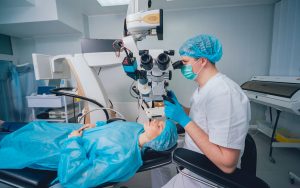Everything You Need To Know About Laser-Assisted Cataract Surgery

Cataract condition makes the lens of your eyes cloudy and compromises clear vision. You might only realize you have cataracts if you undergo a medical examination or when severe symptoms start to show. A cataract is more common in people above 60 years and may inhibit your driving skills at night. Cataract surgery is usually only necessary when the condition interferes with your daily activities.
Have you ever tried looking through a frosty window? Or have you been caught up in traffic on a foggy morning? Cataract patients live like they are caged in a misty room. Their vision is blurred and cloudy, they are sensitive to light, and they don’t see well at night. Our eyes have natural lenses which refract all the light that come in. The lens, or cornea, should thus be clear to achieve clear vision.
Your eyes’ lenses have proteins that provide energy for the refraction of light. When these proteins in the lean break down, you see things as hazy and less colorful. To correct the condition (cataracts), you can undergo Laser-Assisted Cataract Surgery. This article explains everything you need to know about laser-assisted cataract surgery.
What is Laser-Assisted Cataract Surgery
General cataract surgery involves using a small blade to enter the front of the eye. The surgeon then uses another instrument to make a small incision on the outer layer of your eye. The incision breaks down the cataract into tiny pieces before they are removed. Finally, an artificial lens will be inserted to replace the cloudy natural lens.
So, what’s different in laser contact surgery?
Traditional cataract surgery uses blades and other instruments to make incisions. Laser-assisted cataract surgery uses a laser to open your lens and break them into small pieces. According to several studies, laser surgery is more reliable and precise. Even the most experienced surgeons can’t make a perfectly circular opening, but a laser can do it perfectly.
How do you Create the Incision?
Traditional and laser cataract surgery involves making an incision in the cornea’s outer layer. The surgeon uses the incision as a gateway to reach the clouded lens. They will also fix a new artificial lens through the path created by the incision. The surgeon will use a scalpel to create a pathway in traditional cataract surgery. Laser-assisted cataract surgery, however, uses the laser to make the incision.
Breaking the Clouded Lens into Smaller Pieces
In laser-assisted cataract surgery, a surgeon uses a femtosecond laser to prepare the clouded lens for breaking into tiny pieces. The small pieces are removed using a phaco probe.
When should you go for Laser-assisted Cataract Surgery?
You may need to go for laser-assisted cataract surgery if you have a cataract. However, cataract surgery might only be ideal for some. Laser and premium lenses are not covered by insurance and might be costly for many people.
Your doctor can ascertain whether you need to undergo cataract surgery. They will advise whether you need a premium lens and educate you on the surgery’s benefits. Also, your doctor should provide other alternatives if laser-assisted cataract surgery cannot work.
Laser-assisted cataract surgery takes about two to three hours. The procedure takes at most 30 minutes, while the other laser treatment doesn’t last for more than an hour.
What should you expect after Laser-assisted Cataract Surgery?
The recovery process after the surgery should be smooth if you follow all the doctor’s instructions. After a day or two, you should be able to return to your normal household chores and run errands. You might experience mild soreness in the eyes, but the experience might only last a few days.
You will be discharged after the procedure, and you will need to have enough rest. If you can, sleep for the better part of the day to help you recover.
Do not drive a few days after the cataract surgery. You do not need distractions that might interfere with the recovery process. Also, avoid lifting heavy weights for a week or two after the procedure. Be keen while taking a shower; water shouldn’t get into your eyes. Water may contain infectious bacteria and germs which might get into your eyes.
During the recovery process, your eyes are more prone to new infections. It is important to wear post-cataract surgery sunglasses consistently for the first month of recovery. Do not rub your eyes, however uncomfortable they may be. Instead, use eye drops recommended by your doctor.
How long do you take to Heal after Laser-assisted Cataract Surgery?
The surgery takes about 15 to 20 minutes, so you won’t need to spend the whole day in the hospital. According to reports, many patients reported immediate improvements in their vision. However, you might also experience blurry vision after the surgery. The condition, caused by swelling of the eyes, will o away in 4-7 days after the procedure.
The recovery process may depend on one person to another. Full recovery might come after at least five weeks.
Are any risks involved with Laser-assisted Cataract Surgery?
Many adverse post-surgery effects might slow down the recovery process. These risks will develop depending on how the surgeon did the surgery and how you respond to medication. The after-surgery effects include:
- Bleeding
- Swelling of the eye
- Damage to the eye
- Infections
In severe cases, these complications could interfere with your vision. It would help if you kept close to your doctor until you fully recovered. Your doctor should treat the complications as soon as they appear and recommend better ways to reduce further infections.
Some patients also develop a secondary cataract after the cataract surgery. Generally, these risks rarely happen but can also be easily managed.
The Success Rate of Laser-assisted Cataract Surgery
According to the National Institutes of Health, at least 85% of patients who undergo cataract surgery have an almost perfect corrected vision. The report also cites an overall 95% success rate in patients who undergo laser-assisted cataract surgery.
The high success rates reported are due to advanced techniques for performing cataract removal.
Takeaway
If you want the best possible vision without wearing glasses, consider undergoing laser-assisted cataract surgery. But that means you will have to dig deep into your pockets for the extra costs not covered by insurance.
The best thing to do is to talk to your doctor about your vision needs and what you expect after cataract surgery.




